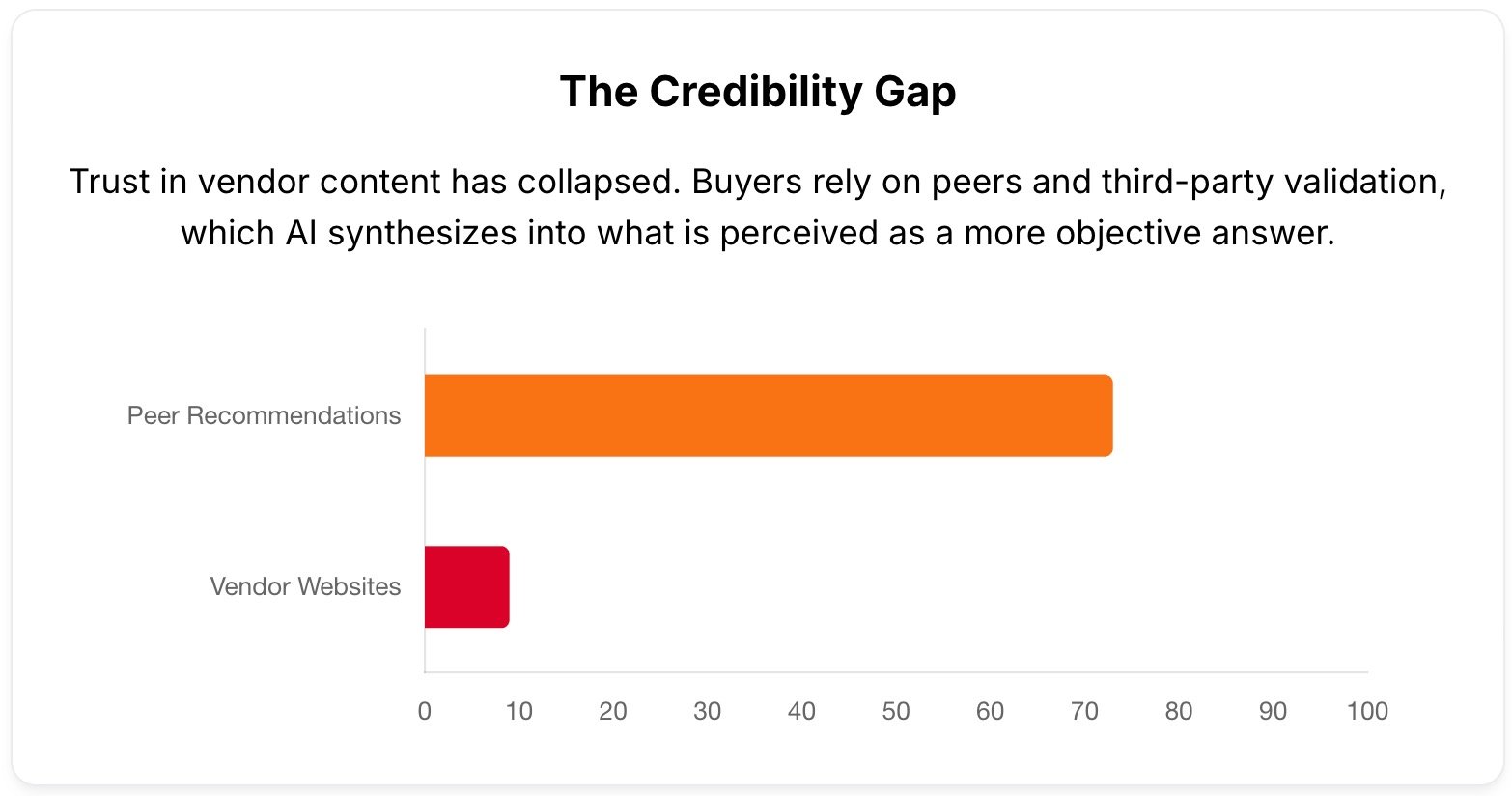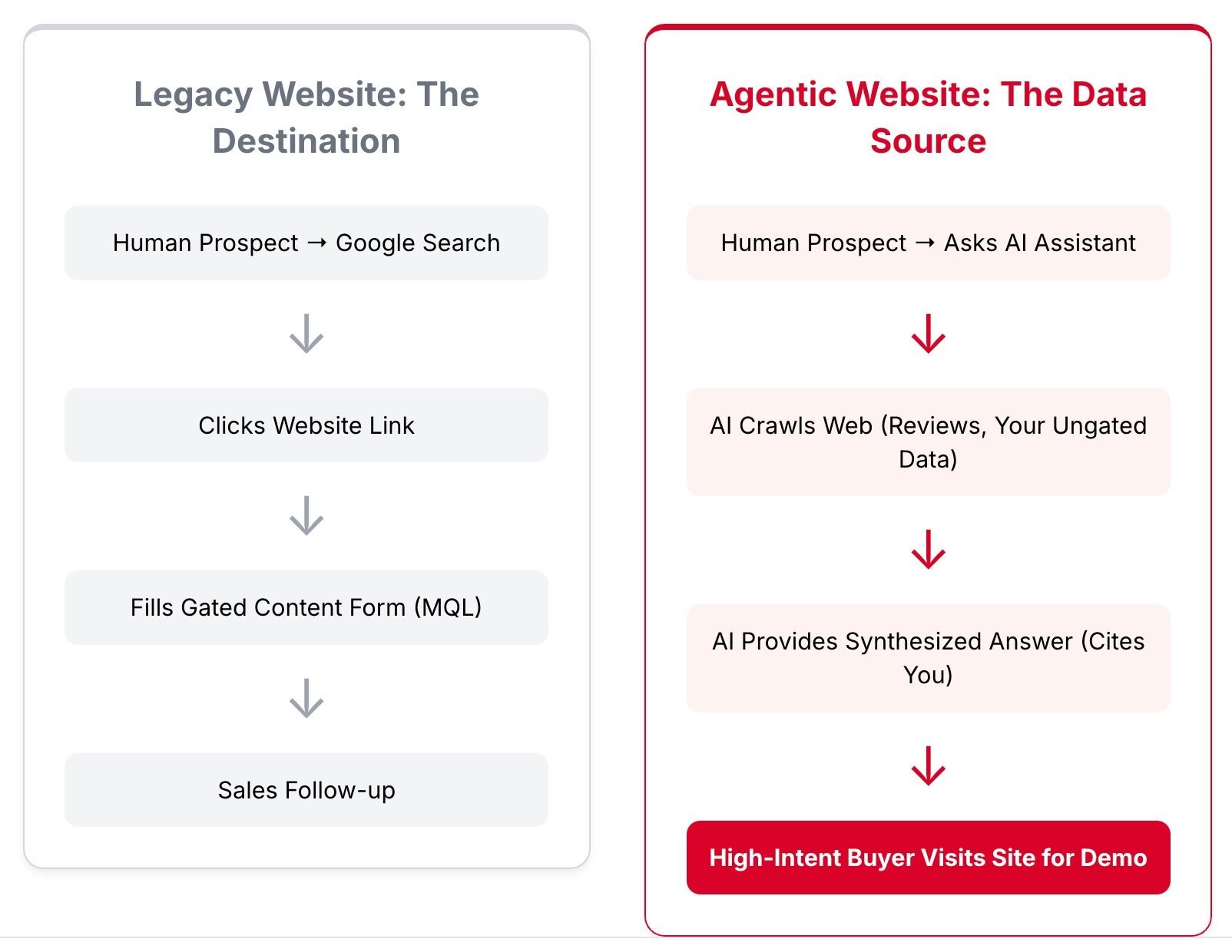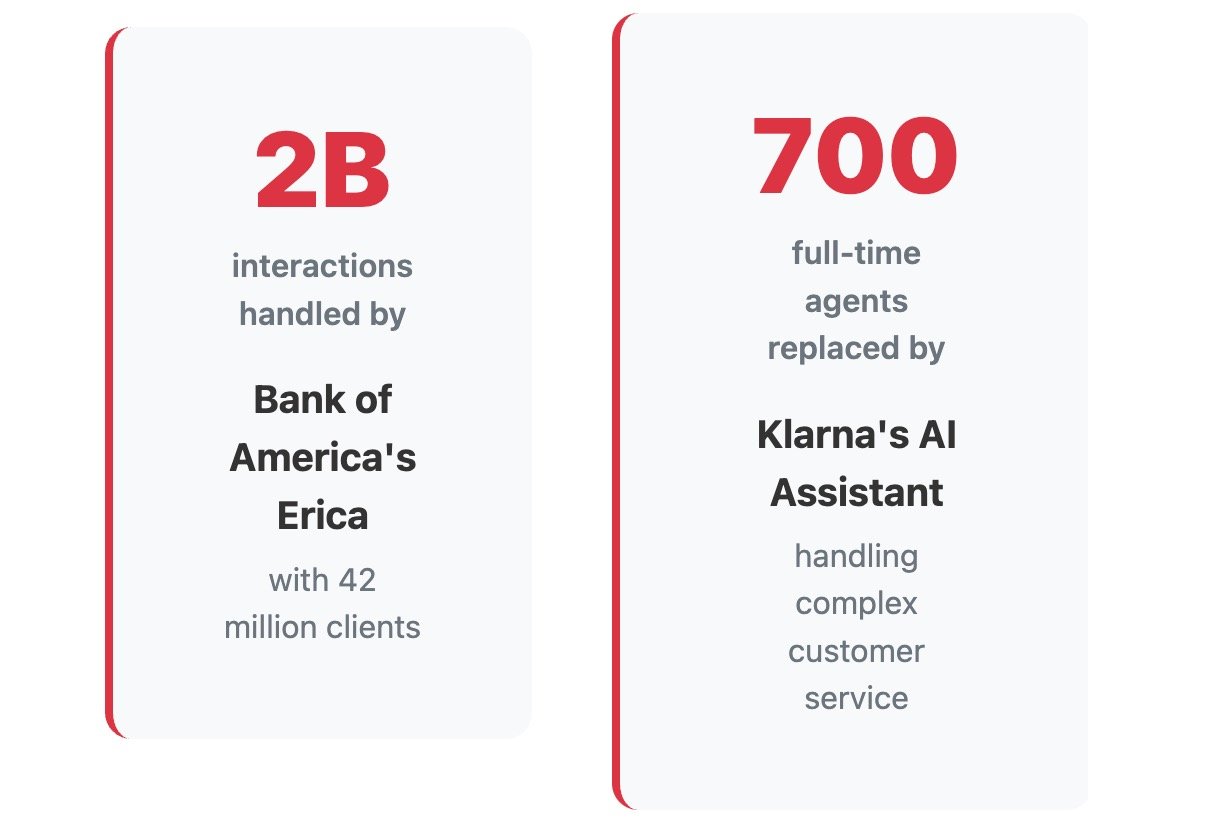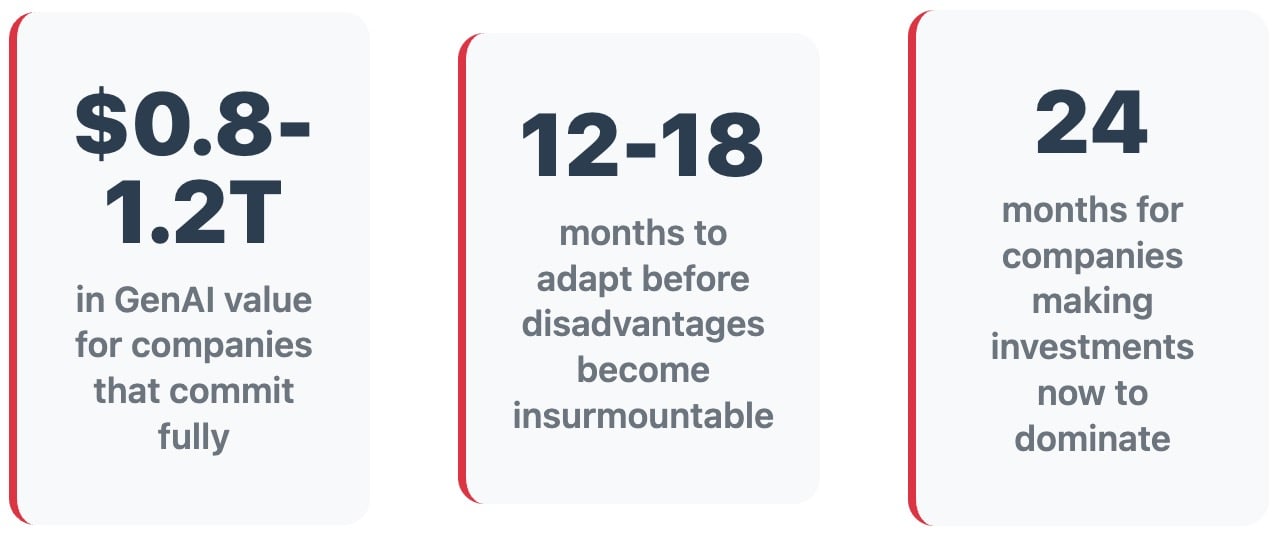The AI-Assisted Buyer: When Buyers Skip Your Website
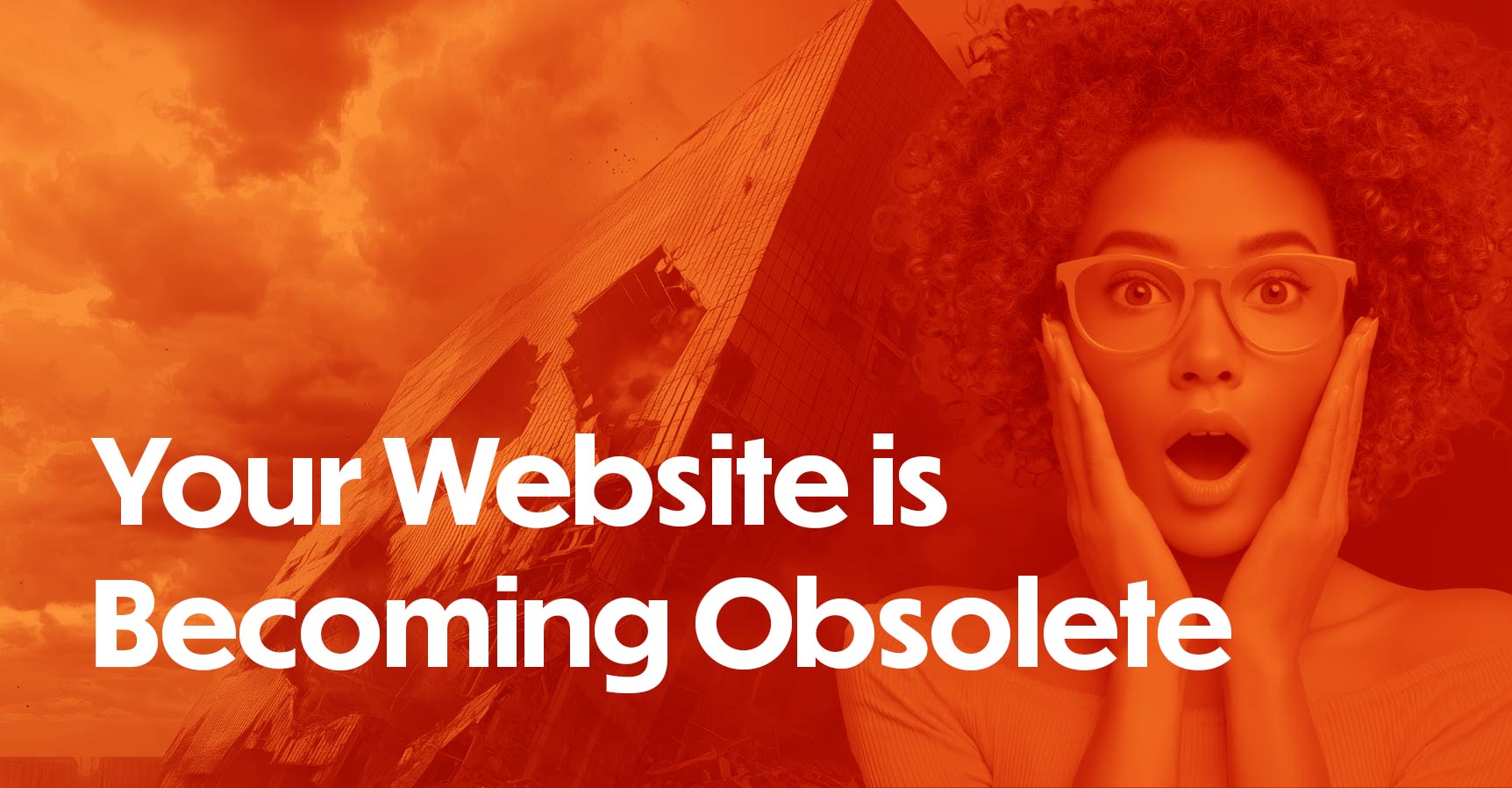
Your corporate website is dying. Not slowly, not eventually—right now.
You won’t see it in Google Analytics—but AI agents are becoming your most important visitors. Welcome to the Agentic Web.
While you’ve been optimizing landing pages and A/B testing button colors, a fundamental shift has occurred in how B2B buyers discover, evaluate and purchase solutions.
Buyers are asking ChatGPT for vendor recommendations instead of googling “best CRM software.” They’re getting instant answers instead of downloading your gated whitepapers.
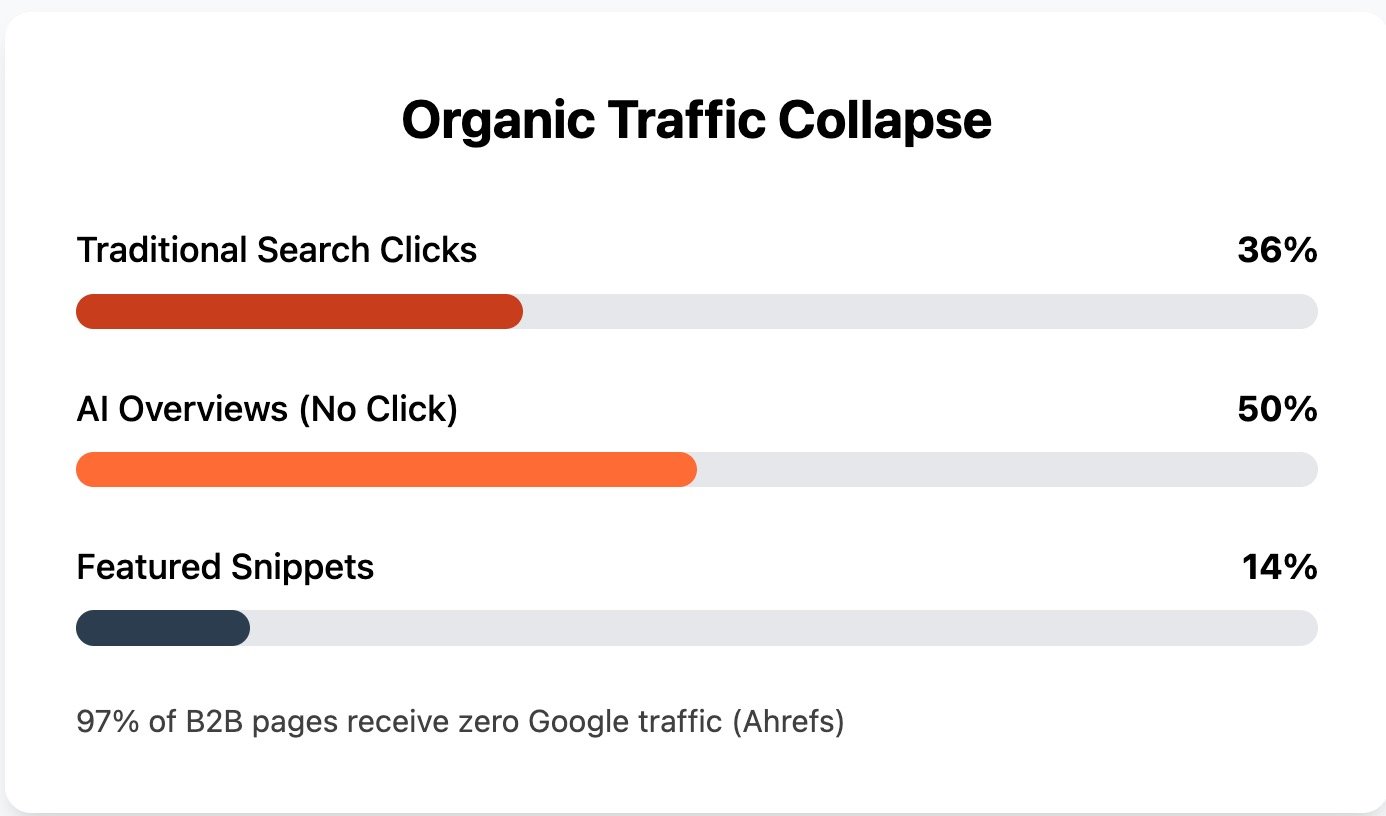
Forbes | Pew Research | aHrefs
This post explains the rise of the Agentic Web—where AI agents, not humans, choose vendors. Learn how structured data, schema, and semantic SEO can make your site readable to AI—and how companies are already seeing measurable gains.
Key Takeaways
- The AI buyer is non-negotiable: 92% of buyers have at least one vendor in mind before they even begin their formal research. Forrester Research
- Your website’s new mandate is to feed accurate, structured data to AI first—because agents read your site before people ever see it.
- The current funnel is broken. The only winning strategy is to build authority across the entire digital ecosystem to influence the AI-driven conversation you can’t see.
B2B buyers are turning to AI tools, not Google. This shift is already disrupting website performance. In private Slack channels and AI-created shortlists, buyers are skipping forms and making decisions before talking to sales. This guide shows what you can do about it.
There are two kinds of AI agents changing how buyers find you.
First are assistive agents you can build today—CustomGPTs and Google Gems. They can run deep competitor research and turn hundreds of pages into a side-by-side comparison in minutes.
Then come fully autonomous agents. Banks are already using them to track contract renewals, renegotiate terms, and execute agreements—cutting renewal cycles by 75% and saving millions. Agentic AI for Banking Contract Renewals
Both are moving the first impression from your homepage to whatever the AI already knows.
The B2B buyer has fundamentally changed.
The old playbook—drive traffic, capture leads, nurture prospects—is breaking down in real time.
Zero-click searches hit ~60% in 2024 and they’re projected to surpass 70% in 2025—already hitting 71% on mobile. What’s driving this?
SparkToro & Datos clickstream study, Jan 2025
Organic Traffic? Don’t Count On It
Your carefully crafted SEO strategy is becoming irrelevant as AI Overviews appear in about 25% to 30% of search results—slashing organic CTRs from 1.41% to 0.64%. Paid CTRs are down too, even when AI Overviews aren’t shown.
Search Engine Land: CTRs Hit New Lows
The buyer’s journey isn’t linear anymore. It’s AI-driven, anonymous, and over before you ever enter the picture. These numbers don’t suggest a shift—they confirm it.
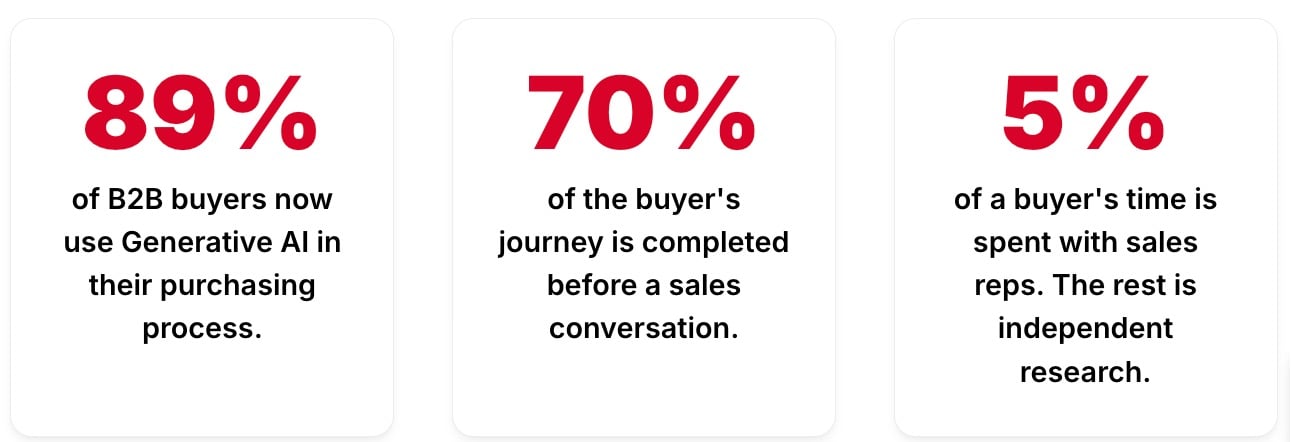
The Future Of B2B Buying | DemandGen Report | Build Better Digital Relationships with Prospects
The “AI-First” generation takes control.
A new generation of digital-native buyers, armed with powerful AI tools, has permanently altered the B2B landscape.
Millennials now represent 73% of all B2B buyers, and they approach purchasing decisions completely differently than their predecessors. They grew up with Google at their fingertips and now have AI in their pocket. They demand self-service, trust peers over vendors, and operate autonomously. Forrester: Millennial Buyers
These buyers don’t want to talk to sales reps until they’re nearly ready to buy.
68% prefer self-service research tools over human conversations. They’ve learned to trust peer reviews (90% consult them before finalizing purchases) more than vendor marketing claims.
AmplifAI Customer Service, 2023 Power Review Survey
What does this mean for your sales process?
Younger stakeholders are using AI to validate vendor claims independently. They’re bypassing traditional approval chains. The buying committee dynamics you’ve relied on for decades? They’re changing fast.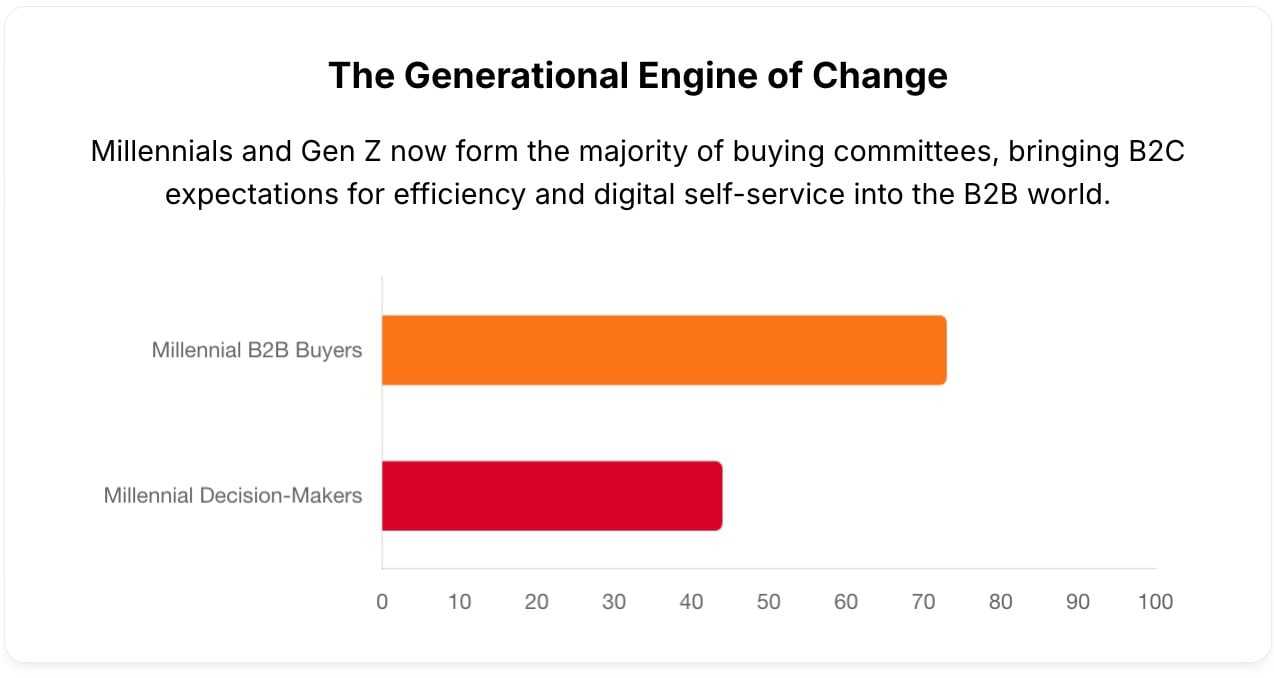 Younger Generations Are Shaking Up B2B Buying.
Younger Generations Are Shaking Up B2B Buying.
But here’s what’s really different: they’re now outsourcing their initial research to AI assistants, and there’s a generational trust divide happening.
How much do Gen Z buyers trust AI-generated content? 30% trust it “always” or “very often,” compared to older generations at just 20%. This matters because ChatGPT processes 37.5 million daily searches, and 61% of Gen Z plus 53% of Millennials use AI tools instead of Google for research queries.
How to Navigate the B2B Buying Landscape | The Verge 2025 Study | Google Quality is Declining
Generative Engine Optimization (GEO)
Explore GEO services and pricing to improve your AI visibility.
AI as the new interface for B2B Buyers
Forget everything you know about the traditional buyer’s journey.
Here’s the kicker: it’s not happening where you can see it. We’re talking AI chat interfaces, private team channels, and those crucial peer conversations that never show up in your analytics.
Industry data shows that up to 80–95% of customer service interactions on websites are now handled by AI agents.ZenDesk Customer Service
 Semrush Impact of AI Search on SEO Traffic
Semrush Impact of AI Search on SEO Traffic
How is the buyer journey changing with AI Agents?
Traditional Path
Google Search → Vendor Websites → Whitepaper/Download → Sales Rep Interaction
AI-Driven Path
Prompt to AI → AI-generated Summary & Comparison → Vendor Shortlist → Late-stage Sales Interaction
Gated content? A strategy past its expiration date.
Lead magnets are dead. When prospects can ask ChatGPT a question and get a comprehensive answer in 30 seconds, why would they fill out a long form just to access your content?
Your competitors who embrace transparency will appear in AI answers. You won’t.
What if your most influential content never shows up?
77.5% of B2B buyers share content through dark social channels—email, messaging apps, private communities. Your attribution models can’t track this activity, which means you’re flying blind on what actually influences decisions.2025 Marketing To Tech
The credibility crisis.
Here’s an uncomfortable reality: your prospects no longer hear your message in your voice.
They encounter your company through AI summaries that strip away your carefully crafted positioning and reduce you to bullet points alongside competitors.
- Only 24% trust AI-generated information completely [Source]
- 47% of enterprise AI users have made major decisions based on potentially inaccurate AI content.Economic Impact of AI Content
TrustRadius reports that AI usage is now mainstream in B2B buying—72% of buyers have already encountered Google’s AI Overviews during vendor research, and 80% now trust AI tools “at least sometimes,” a 19% increase from last year.
And here’s the problem with that: buyers are using AI to research you, but they don’t fully trust what AI tells them. They skip straight past vendor websites and head to third-party platforms before they even think about booking a demo. Trust isn’t being built on your homepage—it’s being earned where your customers already are.Marketing Profs: What B2B Buyers Trust in 2025
And you? You have zero control over how AI presents your company to prospects.
What happens when your website becomes a data mine, not a sales funnel?
The corporate website now serves two sources: human visitors and AI agents with AI agents becoming more important.
McKinsey found that B2B sales teams using AI are seeing 30% productivity gains—here’s how they’re doing it.
Here’s the technical reality: Companies using schema markup are seeing 35% increases in AI-driven traffic. Can Schema Improve AI Search?
From legacy funnels to Agentic influence: Evolving the marketing journey
Conversational AI becomes your front door.
Chatbots are evolving into sophisticated AI assistants that can handle complex B2B conversations. 58% of chatbot usage comes from B2B companies, with leading implementations achieving 40% higher engagement than rule-based alternatives.
What if your website could convert 40% more visitors while simultaneously reducing your support overhead by 30%?
That’s the new reality with AI-powered assistants. They’re no longer simple scripts; with over 85% accuracy in understanding what a visitor wants, they can handle complex conversations that used to require a human. This isn’t just a tool—it’s a new, scalable channel for engaging your most qualified buyers the moment they show interest.
This technology is ready for complex B2B application.
The key is creating seamless handoffs between AI and human interactions. Let AI handle qualification, basic questions, and information delivery. Bring in humans for strategic discussions and relationship building.
How can you prepare for autonomous agents?
Buyers validate vendor claims through trusted third-party sources long before they ever contact sales—and AI agents now mirror this behavior.
A May 2025 report by Search Engine Land found that AI citations favor trusted sources like Wikipedia, G2, Gartner, PCMag and major news outlets.
For B2B queries, company-owned websites account for as little as 3–17% of citations, while independent platforms can make up 60–70% of the sources referenced in AI-generated answers.
Your Wikipedia Page Matters More Than Your Homepage
AI agents fact-check you against Wikipedia, not just your website. They often generate vendor summaries from third-party sources. Wikipedia’s neutral tone is cited more often than most brand content.
Learn more: AI Trains on Wikipedia. Your Business Should Too!
Are you building for AI buyers or human buyers?
The next phase is already emerging: agentic AI that can autonomously resolve 80% of common customer service issues by 2029.
But this is just the beginning.
- 60% of B2B seller work done by AI by 2028 (McKinsey)
- 25% decline in traditional search volume by 2026 (Gartner)
Forward-looking companies are building APIs and data structures for machine-to-machine commerce. Procurement systems will soon execute routine purchases with minimal human oversight, requiring completely different website architectures.
Companies that enable seamless AI agent interactions will capture disproportionate market share as autonomous systems become standard procurement tools.
The New Reality
By the time prospects contact sales in the AI-driven process, they’ve already completed what used to take months of sales-guided education.
What should your new revenue dashboard track?
| DEPRECATE ↓ | ADOPT ↑ | Strategic Value |
|---|---|---|
| MQLs / Lead Volume | High-Quality Inbound Inquiries | Measures actual buying intent, not content downloads. |
| Organic Website Traffic | Branded Search Volume | Indicates brand recall built in the dark funnel. A direct measure of mindshare. |
| Keyword Rankings | Share of AI Citation | Measures influence where buyers get answers. The new “ranking #1.” |
| Form Conversion Rate | Interactive Tool Engagement | Identifies prospects actively “kicking the tires” in late-stage evaluation. |
| Click-Through Rates | AI Agent Interactions | Tracks how effectively AI systems parse and utilize your content for recommendations. |
Your 12-Month Action Plan
Companies have 12-18 months to adapt before competitors lock in long-term AI advantages.
Adapting to the Agentic Web requires a new strategy: Generative AI Optimization (GAIO). This playbook is divided into 3 phases: Foundation, Integration, and Scale. Each phase builds the capabilities needed to compete in an agent-first B2B landscape.
Phase 1: Foundation (Months 1-3)
Goal: Make it easy for AI to find and recommend your content
Quick Wins (Week 1-2)
- Ungate your best content – Remove forms from comparison pages, pricing guides, and feature breakdowns
- Add FAQ sections to your most important pages (AI loves Q&A format)
Month 1-3 Priorities
- Make your content AI-friendly
- Turn long guides into Q&A format
- Add clear headings and bullet points
- Include your company in comparison charts and lists
- Fix the basics
- Add simple tags to help search engines understand your content
- Make sure AI can easily crawl your site
- Create bite-sized content pieces you can reuse everywhere
- Implement schema markup and structured data across your site.
Want proof? Google reported that Nestlé implemented structured data across over 2,000 web pages and saw an 82% increase in search impressions and a 50% increase in click-through rates from enhanced Google rich results.
Phase 2: Integration (Months 4-6)
Goal: Understand how AI is already affecting your buyers
Month 4 Quick Start
- Survey 20 recent customers: “Did you use ChatGPT, Perplexity, or other AI tools to research us?”
- Google your company + ‘vs competitors’ – see what AI tools say about you
Month 4-6 Focus Areas
- Track your AI presence
- Check what AI tools say when people ask about your industry
- See if your content gets quoted or recommended
- Monitor for wrong information about your company
- Prepare your sales team
- Train reps for buyers who already know your basics
- Create talking points for “AI-educated” prospects
- Update lead scoring to include ungated content views
- Fix your tracking
- Ask new leads: “How did you first hear about us?” (many will say AI)
- Start measuring ungated content engagement
- Track “dark social” – people who research you but don’t fill forms
Phase 3: Scale (Months 7-12)
Goal: Build systems that work with AI, not against it
Advanced Moves
- Create AI-ready systems
- Build real-time feeds for pricing and product updates
- Prepare for AI agents that might buy from you automatically
- Create content libraries organized for AI consumption
- Perfect the handoff
- Define when AI research should transition to human sales
- Build better attribution models that account for AI research
- Create feedback loops from sales conversations back to content
- Get ahead of the curve
- Monitor new AI platforms as they emerge
- Test AI-powered nurture sequences
- Prepare for a world where AI does the initial buying research
Time is running out
You can either adapt to the agentic web or watch your competitors capture market share while your traditional tactics lose effectiveness.
McKinsey: The economic potential of GenAI | Is the Window for genAI Closing? | HBR:Invest in AI Heros
The corporate website isn’t disappearing—it’s evolving into the intelligent foundation of AI-mediated commerce.
According to Search Engine Land, “AI discovery is up 527%: Comparing the first 5 months of 2025 with the same time frame in 2024 we see how total sessions from LLMs surged from 17,076 to 107,100 across 19 GA4 properties. Every time the rules changed, early adopters won. This time is no different, except it’s moving faster.”
The window is closing fast. The question isn’t whether this transformation will happen, but whether you’ll lead it or be left behind by it.
Smart companies have already moved on.
Drift, a conversational platform, saw a 15% increase in net new leads after removing gates from previously protected content. The logic is simple: visibility matters more than email addresses when AI systems can’t access gated content.
Source: Should you Ungate Your Content?
The Agentic web is here. Your move.
Still have a question? Check out our FAQs
What is the agentic web and how does it work?
The Agentic Web is where AI agents and assistants do the browsing instead of humans.
Think of it this way: while you're sleeping, AI systems are crawling websites, comparing vendors, and building shortlists for buyers.
These aren't regular search bots. They're smart. They read structured data, parse metadata, and understand relationships between concepts. A human might spend hours researching CRM options. An AI agent does it in seconds.
Here's the kicker: Industry data shows that up to 80–95% of customer service interactions on websites are now handled by AI agents. (source)
Your website needs to speak their language or get ignored.
What's an example of an agent skipping a website?
AI-Powered RFP Response Agents
Vendors like Oracle, Microsoft, and SAP are deploying AI agents that automatically respond to RFPs and procurement inquiries without prospects ever visiting their websites.
When a company posts an RFP for "cloud infrastructure for 10,000 employees," these AI agents:
- Automatically detect the RFP across procurement platforms (like GovSpend, BidNet, or internal procurement portals)
- Generate customized proposals by pulling from structured product data, pricing matrices, and case studies
- Submit comprehensive responses including technical specifications, implementation timelines, and pricing
- Handle follow-up questions and clarification requests through the procurement platform
- Schedule demos and negotiations directly with qualified decision-makers
The buyer never visits the vendor's website. The entire evaluation, comparison, and initial selection happens within the procurement platform or through direct agent-to-agent communication.
Real-world impact: Some enterprise buyers are now receiving 5-10 qualified vendor responses within hours of posting an RFP, compared to the traditional 2-3 week cycle of manual outreach and website research.
Is your content Agent Visibility Ready?
This is what we know now about preparing for the Agentic web :
1. Gated Content
- Ungate top-of-funnel assets: Agents won’t fill out forms—keep early-stage information open to get on the shortlist.
- Publish agent abstracts: Summaries outside the gate can help agents reference your brand even if full access is restricted.
- Use structured summaries: Add a short fact sheet and matching schema markup so agents can pull key brand facts without guessing.
2. PDFs & Downloadable Assets
- Duplicate PDFs in HTML: LLMs don’t do a good job of reading PDFs. Because the data isn’t structured, extraction can be inconsistent and incomplete, leading to poor-quality AI output. HTML ensures your facts are parsed accurately and surfaced reliably.
- Add metadata & schema: Structured data makes product specs and details machine-readable and easy to match in queries.
- Use plain language: Clear language reduces misinterpretation by AI and improves summary accuracy.
3. Core Website Structure
- Use Schema markup everywhere: Ensures agents can identify and classify your content correctly.
- Consistent facts across the web: Mismatched data lowers trust and can disqualify you in automated shortlisting.
- Flat, fast navigation: Agents index content more effectively when it’s fewer than three clicks from the home page.
4. Media & Rich Content
- Provide transcripts or summaries for videos and webinars: LLMs don’t actually watch your video — they read associated text. Without transcripts, they can’t fully understand or cite your content.
- Include alt text for important images: Descriptive tags ensure visual information is accessible to agents.
- Summarize data-heavy visuals: Captures key insights that would otherwise be lost in non-text formats.
How do AI agents navigate and evaluate your website?
Humans browse. AI agents extract.
They pull from structure, text, and data, not visual polish.
When access allows, they can scan many pages fast and generate summaries, tables, and comparisons from what they can retrieve.
Agentic buyer vs. human buyer: What’s changed?
| Stage | Traditional Buyer | Agentic Buyer (AI-Assisted) | Marketing Shift |
|---|
| Discovery | Starts with search (Google, Bing) | Starts with AI prompts (ChatGPT, Gemini) | SEO isn’t enough |
| Research | Reads vendor sites, whitepapers | Consumes LLM summaries and comparisons | Feed the AI, not just your site |
| Evaluation | Clicks links, downloads assets | Scans ungated, structured content across sources | Gated content is invisible |
| Shortlisting | Based on perception and peer input | Based on AI synthesis and trust signals | LLM visibility > traditional ranking |
| Contact | Fills forms, talks to sales | May skip you—AI hands off directly to procurement | You’re in the dark funnel |
| Influencers | Analysts, peers, direct content | LLM-cited sources, forums, structured data | Be quotable, cited, and schema-rich |
| Key Metrics | Traffic, MQLs, form fills | Share of AI citations, inferred intent | New dashboards needed for influence tracking |
How do AI agents decide which websites to trust?
AI agents evaluate trust based on structured data, semantic clarity, site authority, and alignment with user intent.
They rely on schema markup, consistent brand signals, and content that clearly answers specific queries.
Unlike humans, they don’t “browse”—they scan for well-structured, machine-readable signals that suggest a page is reliable, relevant, and safe.
Why is semantic SEO critical for AI agent discoverability?
Forget keyword stuffing. Semantic SEO is about relationships and context.
Traditional SEO targets "CRM software." Semantic SEO connects "customer relationship management" to "sales automation" to "contact management." It maps how concepts relate to each other.
Companies using semantic SEO see 35% more AI-driven traffic. Why? Because AI agents can actually understand what you do instead of just matching keywords.
What is structured data, and why does it matter for AI agents?
Structured data (like Schema.org markup) helps AI agents understand your content’s meaning.
It labels elements such as products, reviews, FAQs, and organization info in a way machines can interpret—boosting discoverability and trust.
Structured data plays a pivotal role in helping both search engines and AI systems understand and categorize your content effectively. Implement schema markup to provide clear, machine-readable context for your content. This approach is particularly crucial for:
- Complex products or services
- Events and time-sensitive information
- Organizational details
- Article and content type specifications
What's the biggest mistake companies are making right now?
They're still optimizing for human visitors only while AI agents take over.
You're A/B testing button colors while competitors are implementing schema markup and seeing massive traffic gains. Stop decorating. Start structuring.
Will human website visitors disappear entirely?
No—while AI agents will handle a growing share of research and decision-making, human visitors will still engage with your site at key points.
Buyers will be far more educated about your brand before they talk to a sales person.
AI often filters and presents options, but humans still make final decisions, especially for complex or high-value purchases.
How can I track AI agent traffic separately from human visitors?
While traditional analytics tools struggle to differentiate agent traffic, server logs and bot filtering tools can help. Look for patterns in visit timing, headers, and user agents that suggest non-human browsing.
More sophisticated solutions are emerging to distinguish AI traffic more accurately.
We asked Claude to analyze one day of our log files and tell us the frequency of AI bots. Claude reported over 10% of our bots are from AI platforms. This was good news.
When do brand searches trigger AI Overviews?
Brand searches typically trigger AI Overviews in these situations:
- Ambiguous or informational queries - When users search "What is [Company Name]?" or want to understand how your product works
- Competitive comparisons - Searches like "[Your Brand] vs [Competitor]" or "best [product category]" often generate AI Overviews comparing multiple options
- Research-stage queries - When Google detects users are in early discovery mode rather than trying to navigate directly to your site
Brand searches typically DON'T trigger AI Overviews for:
- Direct navigation queries like "[Brand] login" or "[Brand] pricing"
- Exact-match branded searches where intent is clearly to reach your website
To increase your chances of appearing in AI Overviews:
- Maintain updated profiles on high-authority sources like Crunchbase and Wikipedia
- Add structured data markup to your website (Organization, Product, FAQ schema)
- Create clear, factual content about your company and services that AI can easily reference
Note: AI Overviews primarily pull from trusted, structured data sources, so having a strong presence in these locations is crucial for brand visibility in AI-generated search summaries.
Rosemary Brisco
AI Training Videos
AI Visibility & Workflow Training
Make your brand easy for LLMs to find and quote.
Teach your marketers practical AI workflows that save hours and lift results.
Start by Training your Marketing Team

